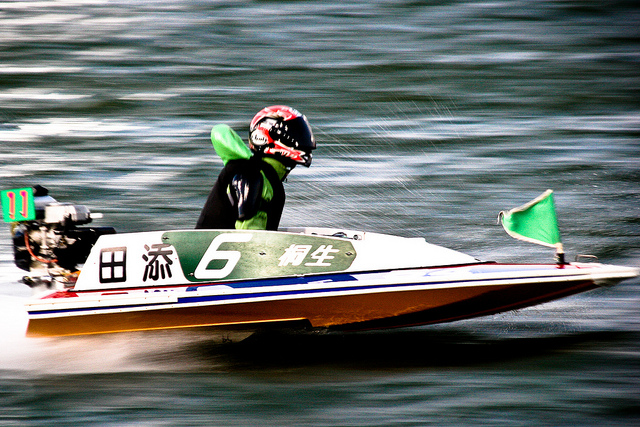Jun 25, 2023
Boat Racing in Aichi
For the uninitiated, criticism of American NASCAR racing tends to center around the fact that it resembles little more than cars driving round and around an oval track. ‘Go straight, turn left,’ critics may complain, lacks the necessary skills that, say, F1 requires.
And I have to admit; I am one of those people. However, imagine if NASCAR was on the water. Now that would be a spectacle, wouldn’t it?
About Boat Racing at Gamagori
Kyōtei, or BOAT RACE as sponsors have dubbed it, is an exhilarating competition that is, in this form, virtually unheard of outside of Japan.
On a 600-meter oval course, competitors on six small hydroplane boats (looking for all the world like suped-up jet skis) fly around at high speed, all vying to take the checkered flag.
Unusual to Kyotei is how much of the action takes place in the build-up to the two-minute race. Using the ‘flying start’ system, boats are signaled to leave their docks to find a starting position, with a one-minute countdown before ‘go time.’
Then, at around 12 seconds before the clock hits zero, the boats hammer towards the start line at full speed, jockeying (pun very much intended) for position, at times crashing into each other, something the locals like to call ‘physical water combat,’ to get the best start. Crossing the starting line either early – before the clock reaches zero – or late – over one second after – results in a disqualification*.
Then, with the race underway, the boats hurtle around the course three times, aquaplaning around the corners at high speed. This is when collisions frequently occur, purposefully or otherwise – that the crowd becomes particularly involved, as this can be where money is lost or won.
Betting on Boat Race
Japan has something of an unusual relationship with gambling. Casinos are banned, as are most forms of sports betting. However, some activities, such as the lottery, are permitted, and pachinko players hop through a loophole letting them ‘sell’ the prizes they win. The other form of acceptable gambling is in the ‘Public Sports’ of horse racing, bicycle racing, speedway, and motorboat racing.
This means that a significant draw of kyōtei for Japanese is that it allows spectators to bet on the races, with revenues raised used to support a wide variety of initiatives, including those of the local municipalities and nonprofit organizations.
Those placing wagers on races can purchase seven varieties of tickets, ranging from bets on one boat to win (tanshō) to as many as three boats to place or show (sanrenpuku), with bets made in 100 JPY increments and payouts divided from a collective pool.
Fun with Friends and family.
The allure of boat racing at Gamagori extends beyond merely the thrill of the speed of the boats, the skills of the riders, and the gambling elements, taking the fun out of the water. The sport has become a social event, bringing people together to cheer on their favorite racers. Though it has historically been a pastime attended by older men, recent years have seen the racing authorities attempt to branch out and diversify its audience. As food and drink are available in the food courts, it has become a hot spot for a place for colleagues to blow off a bit of steam after a hard day at work, and you will often see families enjoying the electric atmosphere and high-octane thrill of the race as well as frequent events with musical performances.
Gamagori Boat Race Details
Where: Gamagori Motorboat Race Field, Ōta Shinden-1-1 Takenoyachō, Gamagōri-shi (map)
Website: gamagori-kyotei.com
* If the boat you have placed a bet on is disqualified at the starting line for this infringement, you will have your stake returned.
**Please remember that if you are looking to place bets on races, gambling is addictive. If you will gamble, gamble responsibly. As one UK-based gambling awareness website has it: when the fun stops, stop!
Photo: by 246-You (CC BY-SA 2.0) via flickr.com -Modified
Photo: by 246-You (CC BY-SA 2.0) via flickr.com -Modified
Photo: via https://www.nippon.com/en/features/jg00023/ © Boat Race Promotion Association-Modified




About the author